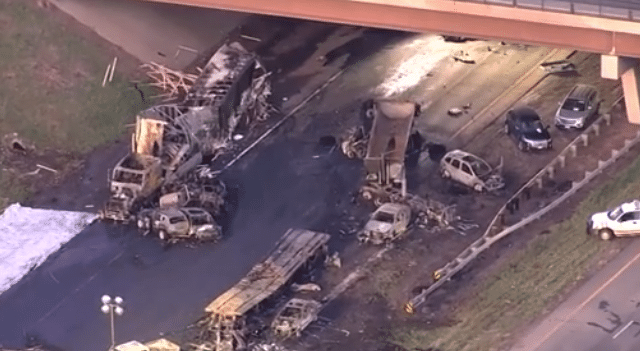Big Rigs. Big Problems.
A commercial semi-truck can weigh upwards of 40 tons, exceed 70 feet in length, and require up to three footballs to stop when travelling at 65mph. The results of a truck accident can be catastrophic. The physical rehabilitation, combined with the financial expenses incurred in a big-rig crash can lead to years of recovery.
Given the destructive nature of semi-truck collisions, it is reasonable to assume there are stringent safety protocols, and legislation, to mitigate the potential carnage. Research indicates otherwise. You may be surprised to learn that many states do not have any criteria for minimum hours behind the wheel. Beyond the occasional multiple-choice exam, the only requirement is an insurance policy.
What does this mean for the safety of our roads? Well, the data is evident: you are at an elevated risk sharing the roads with big rigs. Drivers have fewer requirements and are experiencing greater levels of fatigue than ever before. Commercial trucking collisions are not just sensational headlines. Accidents involving semi-trucks, or 18-wheelers, are on the rise.
Cause for Concern: An Alarming Trend
Vehicular accidents have been on a steady decline for years. This can be attributed to several factors, such as tougher laws for driving under the influence, ride share options, advancements in car safety, implementation of technology to enforce speed limits and deter driving infractions, among many other preventative measures.
But even with a reduction in overall traffic accidents, and an emphasis on driver safety, semi-truck collisions continue to climb. This is a troubling trend that has devasting consequences. In 97 percent of fatal semi-truck accidents, death occurs in the passenger occupant vehicles involved. A fully loaded semi-truck has a mass 25 times greater than the average passenger occupant vehicle. When a collision occurs, it is the occupants of passenger cars who are likely to sustain serious and often fatal injuries.
With the size and weight discrepancy that exists between trucks and passenger vehicles it should be paramount to address the growing rate of accidents. Instead, actions have been taken to amplify the risks of commercial trucking collisions. If the current approach to trucking persists, it will be passenger vehicles and adjacent bystanders who will pay the price.
Increased Pressure: Putting Profits Ahead of Safety
In 2010, the number of fatal accidents that involved a semi-truck was 3700. That figure has increased by over a third, to 4900 fatal incidents in 2020. If proactive methods to improve the safety of our roads have demonstrated to be successful on the whole, what could possibly account for the uptick in semi-truck related accidents?
The answer is economic. Supply chain issues coupled with a relaxation of driver requirements have culminated in a deadly combination on the road. The production and transportation of goods has not returned to pre-pandemic levels, and we are experiencing an unprecedented shortage of truck drivers. The pressure to expedite our economic recovery, in the face of a driver shortage, has led to some dangerous solutions.
One proposal to combat the demand for truck drivers is to lower the federal interstate driving age to 18. It most states it is legal to obtain a CDL at 18, but driving is limited to within the state. To operate a semi-truck on interstate highways and cross state borders, a driver must be 21 years of age. More than likely in the coming year, we will be relying on 18 year old drivers without any proven experience to navigate a semi-truck on narrow roads in inclement conditions.
Incomes for truck drivers have fallen by 50 percent. At the largest fleets in the country, driver turnover is as high as 90 percent. Instead of identifying ways to retain good drivers, and build an infrastructure where experienced drivers can train new drivers, we are establishing a cyclical process where younger, inexperienced drivers will have to meet increasingly lax standards to get behind the wheel for even less pay.
Rinse and repeat. Inexperienced drivers are put into a dangerous situation, often facing financial instability from inconsistent and poor pay, and grueling hours that keep drivers away from their families. In under a year, fleets will move on to the next available cohort of eligible drivers to operate their semi-trucks. This puts the lives of other drivers, as well as semi-truck drivers, in jeopardy.
Ramifications: Present & Future
The ebb and flow of the American economy is contingent on our ability to move goods. Trucking is a volatile industry with high turnover and high rates of burnout. Experienced drivers retired in large numbers during the onset of the pandemic and the positions have not been replaced in any sustainable way. Ports and warehouses have not been able to move their goods and shipping estimates have been delayed months.
While we continue to explore the possibilities of restoring pre-pandemic levels of shipping and distribution, the immediate economic constraints have put trucking companies, and their drivers, in a difficult position. Until we have a revitalized trucking industry and innovations in our transportation sector, we can only assume the current trend of catastrophic semi-truck accidents will continue to surge.
How to Protect Yourself on the Road
Avoid driving in blind spots: A large truck does not have 360 degrees of vision. Tailgating a truck too closely, cutting a truck off in front too quickly or too closely, and driving adjacent to the truck, but behind the window of the driver will you in the semi-trucks blind spots, or “no-zones.” Do not stay in any of these positions for any longer than is necessary, as the operator of the truck will not be able to see you.
Provide space and use caution when passing: Trucks require more space to turn and will pick up speed when driving downhill. It is best to wait until you have a flat stretch of road to pass a truck. Always pass in the left lane, never the right lane, and make it as quick as possible. Always use a turn signal and provide ample time to notify the driver of the truck you will be coming up on his left.
Remain calm and be smart: Given the sheer size and weight of a semi-truck, the time required to speed up, slow down, and navigate roads is very different from a typical occupant passenger vehicle. Allow the truck to take the appropriate amount off time to maneuver a turn or accelerate at a light. Acting impatiently and attempting to get around a semi-truck can be a deadly way to save a little extra time.
If You Are Involved in a Semi Truck Accident
80,000 pounds of steel and cargo, traveling at speeds in excess of 75mph can do untold amounts of damage. The physical rehabilitation, combined with the financial expenses incurred in a big-rig crash can lead to years of recovery. The list of possible damages can be exhaustive, medical bills, lost income, pain & suffering, emotional trauma, property damages, rehabilitation, health care, and in the event of a wrongful death, burial expenses, and other associated costs.
Given that commercial semi-truck collisions are some of the most severe accidents to occur on the road, they can be some of the most complex regarding liability. For example, though a driver of the truck may have been operating in negligent manner, the accident could also be the result of a malfunction or poorly maintained infrastructure. Liable parties could include the truck driver’s employer, the company that owns the truck, the vehicle manufacturer, or government entities that oversee the roads where the accident occurred.
If you or your loved one has been injured in a trucking accident – follow these steps closely to avoid making serious and critical mistakes.
Can companies be held responsible for semi-truck accidents caused by relaxed driver requirements and supply chain issues?
As supply chain issues lead to a greater number of semi-truck accidents, many people want to hold logistics companies accountable. However, there are ways for truck accident victims to go after trucking companies directly. You may be able to file a personal injury claim against the trucking company if any of the following factors caused the accident:
- The driver was improperly trained or licensed: There are strict training and licensing requirements for all commercial truck drivers. If the driver of the vehicle that hit you wasn’t licensed correctly or got on the road before completing their training, their employer may be liable for the crash.
- The commercial truck was not maintained: Shorter shipping times coupled with supply chain issues force trucks to spend more time on the road and less time in the shop. When trucks go too long without getting proper maintenance, it puts everyone on the road at risk. Fortunately, semi-truck owners and logistics companies can be held liable for crashes caused by poor maintenance.
- The truck driver did not take their mandatory rest periods: When drivers are overworked, they may skip out on mandatory rest periods. These rest breaks help ensure that drivers are always awake and alert behind the wheel. If a driver skips these required breaks, they can be held responsible for the crash—especially if the employer encouraged this behavior.
- The truck was improperly loaded: Trailer cargo needs to be properly loaded and secured. If objects suddenly shift in the cargo area, it can cause a truck to lose control and slam into other vehicles. If your accident was caused by unsecured cargo, both the trucking company and the company that loaded the truck may be held liable for the crash.
If you suspect that your accident resulted from any of these factors, speak with an experienced semi-truck accident attorney. An attorney can help you bring a case forward and ensure that you get the compensation you deserve for your injury.


